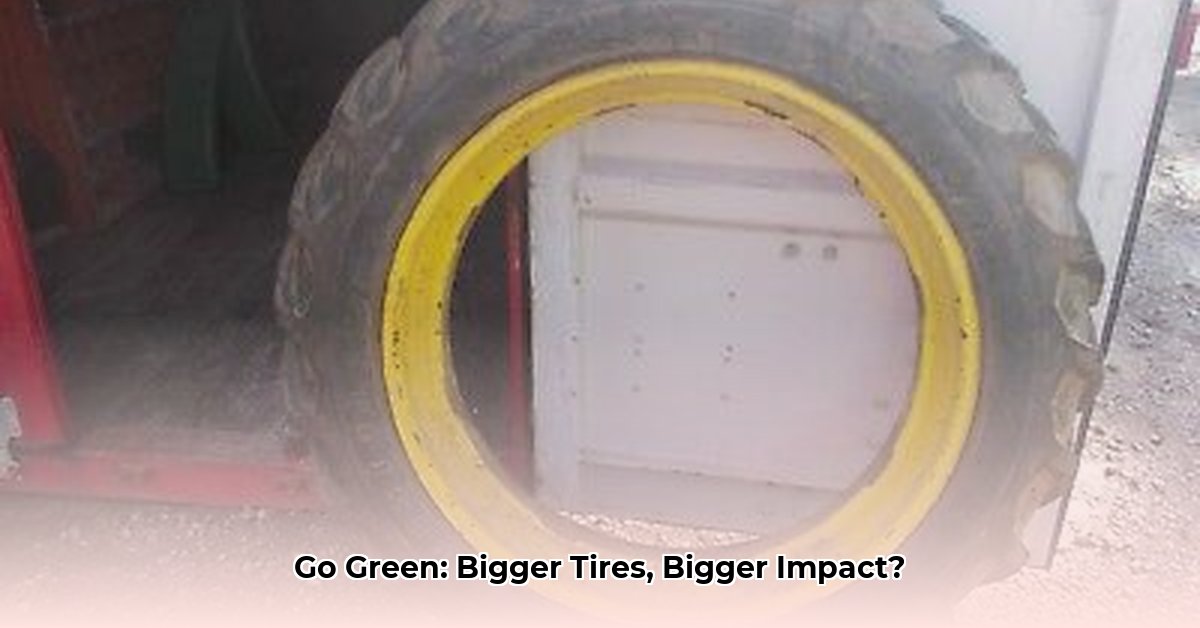
38 Inch Tractor Tires: Paving the Way for Sustainable Agriculture
Choosing the right tractor tires is a critical decision for any farmer, especially when sustainability is a priority. This deep dive explores the benefits of 38-inch tractor tires in promoting environmentally friendly farming practices, examining their impact on soil health, fuel efficiency, and overall farm operations. We'll also explore tire selection, maintenance, and emerging trends in sustainable tire technology. For more information on smaller tractor tires, check out this helpful resource. Larger diameter tires, such as 38-inch options, offer several advantages for sustainable agriculture. Aren't reduced environmental impact and increased profitability attractive goals?
Lighter Footprint, Healthier Soil
The larger contact area of 38-inch tires distributes the tractor's weight more effectively, reducing soil compaction. This is crucial because compacted soil hinders water infiltration and nutrient uptake, leading to lower crop yields and degraded soil health. Reduced compaction, facilitated by these larger tires, allows for better water retention, potentially reducing irrigation needs.
Dr. Amelia Hernandez, Agricultural Engineer at Purdue University, states, "Minimizing soil compaction is paramount for long-term soil health. Larger diameter tires, like the 38-inch option, offer a significant advantage in reducing compaction and promoting sustainable farming practices."
Fuel Savings: A Win for Your Wallet and the Planet
Lower rolling resistance is a key advantage of larger tires. This translates directly into fuel savings, benefiting both your farm's bottom line and the environment. The less fuel consumed, the lower the greenhouse gas emissions. Studies are showing a significant correlation between tire size and fuel consumption, with larger diameter tires consistently demonstrating superior fuel efficiency. How much will your farm save? Initial data suggests significant potential.
Extended Tire Lifespan, Less Waste
High-quality 38-inch tires are built to last. This translates to fewer replacements over time, reducing waste in landfills and the environmental impact of tire production. This simple step significantly contributes to waste reduction and responsible resource management.
Precision Farming Enhancement
The stability and larger contact patch of 38-inch tires improve the precision of GPS-guided machinery. This leads to more accurate application of fertilizers and pesticides, minimizing waste and environmental pollution—a crucial aspect of sustainability. Improved maneuverability also contributes to efficient field operations, potentially reducing both time and fuel consumption.
Choosing Your Ideal 38-Inch Tires: A Practical Guide
Selecting the right tires is critical for maximizing benefits. Follow these steps:
- Assess Your Farm's Needs: Consider your soil type (clay, sandy, etc.), tractor weight, and usual workload. This is the foundational step for effective tire selection.
- Analyze Tire Specifications: Examine tread depth (crucial for traction and lifespan), load capacity, and rolling resistance ratings. Understand how different specifications influence efficiency.
- Compare Thoroughly: Consider not only the initial cost but also the warranty and projected lifespan. A longer-lasting tire might prove more cost-effective in the long run.
- Consult Experts: Discuss your needs with your equipment dealer or an agricultural engineer to ensure optimum tire selection for your specific circumstances.
- Maintain Correct Inflation: Constantly monitor and adjust tire pressure. Improper inflation dramatically affects both soil compaction and tire lifespan.
The Future of Sustainable Tire Technology
The agricultural sector is embracing innovation in tire technology. The development of bio-based rubber, utilizing renewable resources, promises to significantly reduce the carbon footprint of tire production. Additionally, tire-as-a-service models are gaining traction, offering flexible leasing options and potentially optimized tire management.
Weighing the Pros and Cons
While 38-inch tires offer many advantages, it is important to balance them against potential drawbacks:
| Pros | Cons |
|---|---|
| Reduced soil compaction | Higher initial cost |
| Improved fuel efficiency | Potential equipment adjustments (width considerations) |
| Extended tire lifespan | Regional availability limitations |
| Enhanced precision agriculture capabilities | Increased maintenance (depending on operating conditions) |
| Sustainable farming contribution | Requires careful consideration of soil types and operating conditions |
How to Choose Sustainable Tractor Tires for Reduced Soil Compaction
Key Takeaways:
- Soil compaction negatively impacts crop yields and soil health. Mitigation is key to sustainable practices.
- Tire selection is paramount in reducing compaction. Size, pressure, and design are crucial.
- 38-inch tires offer a balance between traction and reduced ground pressure, but proper selection is crucial.
- Sustainable practices encompass tire choice, inflation, maintenance, and responsible disposal.
- Continuous advancements in tire technology promise to further reduce environmental impact.
Understanding the Challenge: Soil Compaction
Soil compaction severely reduces crop yields by hindering water and nutrient access to plant roots. Heavy machinery use significantly contributes to compaction.
The Role of Tire Technology in Mitigating Soil Compaction
Optimizing ground pressure is key. Larger tires like 38-inch models distribute weight more effectively. Lower inflation pressures also help, but maintaining the correct pressure (using a monitor if possible) is critical to avoid damage and maintain efficiency.
38-Inch Tires: A Detailed Look
38-inch tires offer a good balance for many applications. However, the ideal tire size depends on tractor weight, soil type, and operational needs. A soil analysis and tractor weighing are advisable before purchasing.
Sustainable Practices Beyond Tire Selection
Proper inflation is crucial to avoid both tire damage and excessive compaction. Responsible recycling or reuse practices are essential for minimizing environmental impact at the end of the tire's life.
Emerging Trends: The Path Forward
Innovations in bio-based rubber and "tire-as-a-service" models are shaping the future of sustainable tire technology, promising more efficient and environmentally friendly solutions.